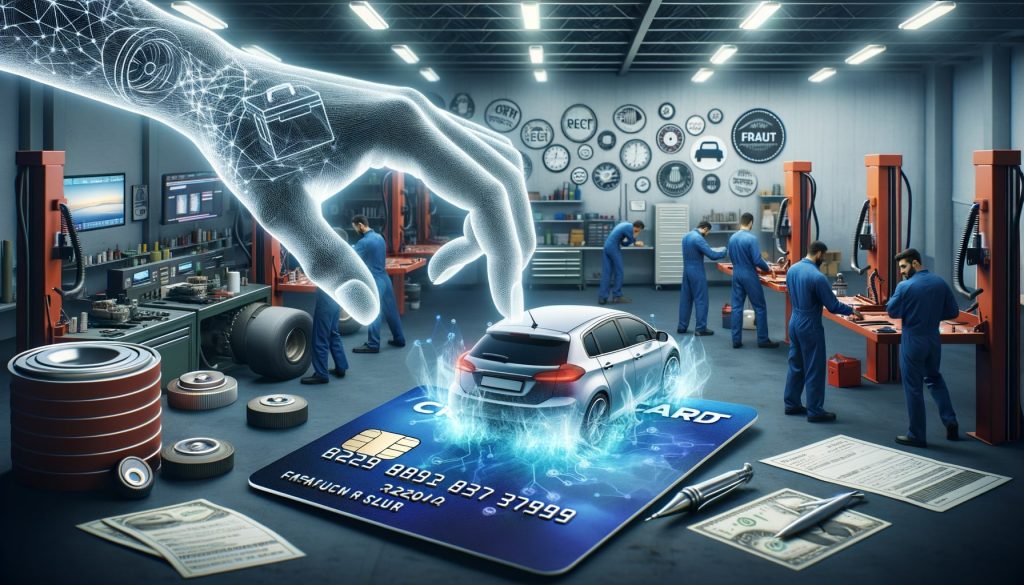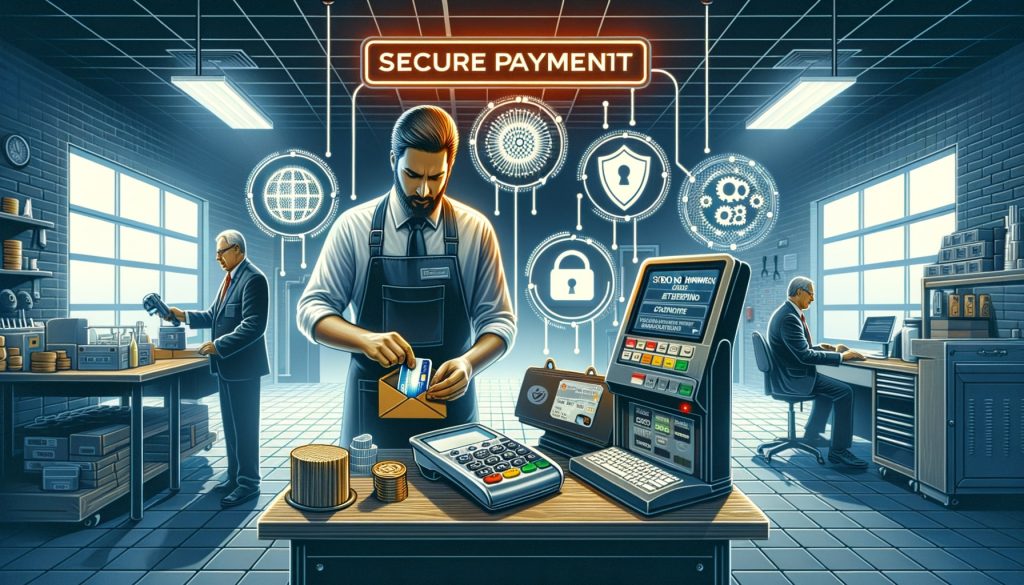Credit card fraud is a growing concern in various industries, and auto repair shops are no exception. With the increasing reliance on electronic payments, criminals have found new ways to exploit vulnerabilities in payment systems. This article aims to provide a comprehensive guide on how to prevent credit card fraud in auto repair shops. By understanding the prevalence of credit card fraud, common types of fraud, and the reasons why auto repair shops are vulnerable, shop owners and managers can take proactive steps to protect their customers and their business.
What is Credit Card Fraud?

Credit card fraud occurs when someone uses stolen or unauthorized credit card information to make purchases or withdraw funds. For auto repair shops, this often involves fraudulent transactions for services or products such as car parts, vehicle repairs, or even down payments on vehicles. Fraud can occur both in-person and through online transactions, making it essential to secure all payment channels.
Common Types of Credit Card Fraud in Auto Repair Shops
- Card-Present Fraud: Occurs when a fraudster physically presents a stolen or counterfeit card at the auto repair shop to make a payment.
- Card-Not-Present (CNP) Fraud: Happens when a fraudster uses stolen card information to make payments over the phone, online, or through mobile apps.
- Chargeback Fraud: When a customer makes a legitimate purchase but later disputes the charge, claiming it was unauthorized, resulting in a refund.
- Skimming: Fraudsters use devices to capture card information from POS systems or card readers, which is then used to make unauthorized transactions.
- Account Takeover: Fraudsters gain access to a customer’s account and make fraudulent transactions, often by hacking into online accounts or mobile apps.
Why Are Auto Repair Shops Vulnerable to Credit Card Fraud?
Auto repair shops are frequent targets for credit card fraud due to the nature of their business. The combination of high-value transactions and a wide range of payment methods makes them attractive to fraudsters. Here are some key factors that contribute to this vulnerability:
1. High-Value Transactions
Auto repair shops often deal with high-ticket transactions, such as expensive vehicle repairs or parts. Fraudsters are attracted to these large transactions, as they offer the potential for significant financial gain.
2. Multiple Payment Channels
Auto repair shops typically accept a variety of payment methods, including credit cards, debit cards, and mobile payments. With the increasing use of online payments and mobile apps, the risk of fraud, especially in card-not-present transactions, is higher.
3. Lack of Employee Training
In some cases, employees may not be adequately trained to recognize signs of credit card fraud or follow security best practices during payment processing, leaving the business vulnerable to fraudulent transactions.
4. Minimal Fraud Detection Systems
Many auto repair shops lack robust fraud detection systems, making it easier for fraudsters to exploit security gaps. Without advanced fraud detection tools, businesses may fail to catch suspicious transactions early on.
How to Detect Credit Card Fraud in Auto Repair Shops

Detecting credit card fraud in auto repair shops requires vigilance and attention to detail. Here are some signs that may indicate fraudulent activities:
- Unusual or Large Transactions: Keep an eye out for transactions that are significantly higher than the average ticket size or seem out of the ordinary. Fraudsters often make large purchases to maximize their gains before the stolen credit card information is reported.
- Multiple Declined Transactions: If you notice multiple declined transactions from different customers using different credit cards, it could be a sign of fraudulent activity. Fraudsters may attempt to use multiple stolen credit cards until they find one that works.
- Inconsistent Customer Information: Pay attention to inconsistencies in customer information, such as mismatched names, addresses, or contact details. Fraudsters may provide false information to avoid detection.
- Sudden Increase in Chargebacks: Chargebacks occur when customers dispute a transaction and request a refund from their credit card issuer. A sudden increase in chargebacks can indicate a pattern of fraudulent transactions.
- Unusual Behavior or Requests: Be wary of customers who exhibit suspicious behavior, such as rushing through the payment process, insisting on using a specific payment method, or requesting multiple transactions in a short period.
How to Prevent Credit Card Fraud in Auto Repair Shops
Preventing credit card fraud in auto repair shops requires a multi-layered approach that combines technology, employee training, and collaboration with payment processors and banks. Here are some effective strategies to implement:
- Upgrade Payment Systems: Invest in secure payment systems that comply with Payment Card Industry Data Security Standard (PCI DSS) requirements. These systems encrypt customer data during transmission and storage, making it difficult for fraudsters to access sensitive information.
- Implement Two-Factor Authentication: Two-factor authentication adds an extra layer of security by requiring customers to provide additional verification, such as a unique code sent to their mobile device, before completing a transaction.
- Use Tokenization: Tokenization replaces sensitive credit card information with a unique identifier or token. This ensures that even if the token is intercepted, it cannot be used to make fraudulent transactions.
- Regularly Update Software and Security Patches: Keep all software and security patches up to date to protect against known vulnerabilities. Regularly check for updates from your payment system provider and install them promptly.
- Secure Wi-Fi Networks: Ensure that your shop’s Wi-Fi network is password-protected and encrypted. Public or unsecured networks can be easily compromised, allowing fraudsters to intercept customer data.
- Train Employees on Fraud Detection: Provide comprehensive training to your employees on how to detect and prevent credit card fraud. Teach them to recognize suspicious behavior, verify customer information, and follow proper payment processing procedures.
- Monitor Transactions and Customer Data: Regularly review transaction logs and customer data for any anomalies or suspicious patterns. Implement automated monitoring systems that can flag potentially fraudulent transactions in real-time.
- Implement Strong Password Policies: Enforce strong password policies for all systems and accounts used in your auto repair shop. Encourage employees to use unique, complex passwords and change them regularly.
- Limit Access to Customer Data: Grant access to customer data only to authorized personnel who need it to perform their job duties. Implement role-based access controls to ensure that employees can only access the information necessary for their roles.
- Regularly Conduct Security Audits: Periodically assess your shop’s security measures and conduct vulnerability scans to identify any weaknesses or potential entry points for fraudsters. Address any vulnerabilities promptly to maintain a secure environment.
How to Respond to Credit Card Fraud in Auto Repair Shops

Even with strong prevention measures in place, credit card fraud can still occur. Knowing how to respond quickly and effectively can minimize financial losses and protect your business’s reputation.
1. Identify the Fraudulent Transaction
When fraud is suspected, review transaction logs and records to identify the suspicious transaction. Look for discrepancies in the transaction, such as mismatched customer details or unusually large purchases.
2. Contact Your Payment Processor
Notify your payment processor immediately if you suspect credit card fraud. Your processor can help you block future fraudulent transactions and guide you through the process of disputing or reversing the fraudulent charge.
3. Notify the Affected Customer
Contact the affected customer to inform them of the fraudulent transaction. Advise them to monitor their account for any other unauthorized transactions and report the fraud to their credit card issuer. Assure them that your business is taking steps to address the issue and protect their data.
4. Conduct an Internal Investigation
Launch an internal investigation to determine how the fraud occurred. Review payment processes, employee actions, and security protocols to identify any gaps that may have allowed the fraud to happen. Use the findings to strengthen your security measures.
5. Improve Security Protocols
Based on the results of your investigation, implement improvements to your security protocols to prevent future fraud. This could include updating payment systems, retraining employees, or upgrading security technologies such as encryption and tokenization.
6. Report the Fraud to Authorities
In cases of significant fraud, report the incident to local law enforcement or cybercrime authorities. Provide them with any relevant information, such as transaction records and surveillance footage, to assist in their investigation.
Implementing Secure Payment Systems: Best Practices for Auto Repair Shops

Implementing secure payment systems is crucial for preventing credit card fraud in auto repair shops. Here are some best practices to follow:
- Choose a PCI DSS Compliant Payment System: Select a payment system that complies with the Payment Card Industry Data Security Standard (PCI DSS). This ensures that the system meets industry security standards and protects customer data.
- Use Point-to-Point Encryption (P2PE): Point-to-Point Encryption encrypts credit card data at the point of capture and keeps it encrypted until it reaches the payment processor. This prevents unauthorized access to sensitive information.
- Enable EMV Chip Card Acceptance: EMV chip cards provide an added layer of security compared to traditional magnetic stripe cards. Ensure that your payment system supports EMV chip card acceptance to reduce the risk of counterfeit card fraud.
- Enable Contactless Payments: Contactless payment methods, such as mobile wallets or contactless cards, offer enhanced security and convenience. Enable contactless payment options to provide customers with a secure and frictionless payment experience.
- Regularly Update and Patch Payment Systems: Keep your payment systems up to date with the latest software and security patches. Regularly check for updates from your payment system provider and install them promptly to protect against known vulnerabilities.
Training Staff to Detect and Prevent Credit Card Fraud

Employee training plays a crucial role in preventing credit card fraud in auto repair shops. Here are some key areas to focus on when training your staff:
- Recognizing Suspicious Behavior: Train your employees to recognize suspicious behavior, such as customers who seem overly anxious or rush through the payment process. Encourage them to trust their instincts and report any concerns to management.
- Verifying Customer Information: Teach your employees to verify customer information, such as matching the name on the credit card with the identification provided. Instruct them to request additional identification if necessary.
- Following Payment Processing Procedures: Ensure that your employees follow proper payment processing procedures, including obtaining authorization for transactions and verifying signatures when required. Emphasize the importance of accuracy and attention to detail.
- Handling Customer Data: Train your employees on how to handle customer data securely. Instruct them not to write down or store credit card information and to dispose of any printed customer data properly.
- Reporting Suspicious Activity: Create a culture of vigilance and encourage your employees to report any suspicious activity or concerns promptly. Establish clear channels of communication for reporting incidents and provide guidance on the appropriate steps to take.
Securing Customer Data: Importance of Data Protection Measures
Securing customer data is paramount in preventing credit card fraud in auto repair shops. Here are some essential data protection measures to implement:
- Encrypt Customer Data: Encrypt all customer data, including credit card information, during transmission and storage. Encryption ensures that even if the data is intercepted, it remains unreadable and unusable to unauthorized individuals.
- Implement Access Controls: Restrict access to customer data to authorized personnel only. Implement role-based access controls to ensure that employees can only access the information necessary for their job duties.
- Regularly Back Up Data: Regularly back up customer data to secure servers or cloud storage. This ensures that even if your systems are compromised, you can restore customer data and minimize the impact on affected individuals.
- Secure Physical Storage: If you store physical copies of customer data, ensure that it is stored securely in locked cabinets or rooms with restricted access. Implement measures to prevent unauthorized individuals from accessing or removing customer data.
- Dispose of Data Properly: Establish procedures for the proper disposal of customer data, such as shredding physical documents or securely erasing electronic files. Train your employees on these procedures to prevent data breaches through improper disposal.
Collaborating with Payment Processors and Banks: Strengthening Security Measures
Collaborating with payment processors and banks can significantly enhance the security measures in your auto repair shop. Here are some ways to strengthen your collaboration:
- Stay Informed about Security Updates: Regularly communicate with your payment processor and bank to stay informed about the latest security updates and best practices. They can provide guidance on implementing additional security measures and address any concerns or questions you may have.
- Report Suspicious Transactions: If you notice any suspicious transactions or suspect credit card fraud, report it to your payment processor and bank immediately. They can investigate the incident and potentially block or reverse fraudulent transactions.
- Implement Fraud Detection Tools: Work with your payment processor to implement fraud detection tools that can analyze transaction patterns and identify potential fraudulent activities. These tools can help you detect and prevent credit card fraud in real-time.
- Monitor Chargebacks: Regularly monitor chargebacks and work closely with your payment processor to identify any patterns or trends. High chargeback rates can indicate fraudulent activities or customer dissatisfaction, requiring further investigation.
- Conduct Regular Security Audits: Collaborate with your payment processor and bank to conduct regular security audits of your payment systems and processes. These audits can identify vulnerabilities and help you implement necessary security enhancements.
FAQs
Q1. What is the most common type of credit card fraud in auto repair shops?
Card-present fraud, where a fraudster physically uses a stolen or counterfeit card, is common in auto repair shops due to the high value of transactions. Card-not-present (CNP) fraud is also on the rise with the increased use of online payments.
Q2. How can auto repair shops protect against online fraud?
To protect against online fraud, auto repair shops should use secure payment gateways, SSL encryption, two-factor authentication (2FA), and fraud detection tools to monitor transactions.
Q3. What should I do if I detect a fraudulent transaction?
If you detect a fraudulent transaction, notify your payment processor immediately, contact the affected customer, investigate the incident internally, and strengthen your security measures to prevent future fraud.
Q4. How does EMV chip technology help prevent fraud?
EMV chip technology generates a unique transaction code for each payment, making it nearly impossible for fraudsters to clone or replicate card data. This significantly reduces the risk of card-present fraud.
Q5. Can chargebacks be prevented?
While it’s impossible to eliminate chargebacks entirely, you can reduce the risk by keeping detailed transaction records, clearly communicating policies to customers, and responding promptly to disputes with the necessary documentation.
Conclusion
Preventing credit card fraud in auto repair shops requires a proactive and multi-layered approach. By understanding the prevalence of credit card fraud, common types of fraud, and the reasons why auto repair shops are vulnerable, shop owners and managers can implement effective preventive measures. Upgrading payment systems, training staff to detect and prevent fraud, securing customer data, and collaborating with payment processors and banks are essential steps in protecting both customers and the business.
By implementing these strategies, auto repair shops can create a secure environment for their customers and maintain their reputation as trustworthy service providers.
